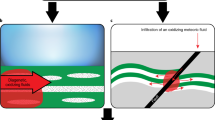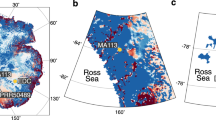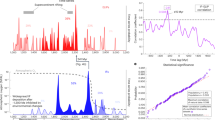Abstract
Astronomical forcing associated with Earth’s orbital and inclination parameters (Milankovitch forcing) exerts a major control on climate as recorded in the sedimentary rock record, but its influence in deep time is largely unknown. Banded iron formations, iron-rich marine sediments older than 1.8 billion years, offer unique insight into the early Earth’s environment. Their origin and distinctive layering have been explained by various mechanisms, including hydrothermal plume activity, the redox evolution of the oceans, microbial and diagenetic processes, sea-level fluctuations, and seasonal or tidal forcing. However, their potential link to past climate oscillations remains unexplored. Here we use cyclostratigraphic analysis combined with high-precision uranium–lead dating to investigate the potential influence of Milankovitch forcing on their deposition. Field exposures of the 2.48-billion-year-old Kuruman Banded Iron Formation reveal a well-defined hierarchical cycle pattern in the weathering profile that is laterally continuous over at least 250 km. The isotopic ages constrain the sedimentation rate at 10 m Myr−1 and link the observed cycles to known eccentricity oscillations with periods of 405 thousand and about 1.4 to 1.6 million years. We conclude that long-period, Milankovitch-forced climate cycles exerted a primary control on large-scale compositional variations in banded iron formations.
This is a preview of subscription content, access via your institution
Access options
Access Nature and 54 other Nature Portfolio journals
Get Nature+, our best-value online-access subscription
$29.99 / 30 days
cancel any time
Subscribe to this journal
Receive 12 print issues and online access
$259.00 per year
only $21.58 per issue
Buy this article
- Purchase on Springer Link
- Instant access to full article PDF
Prices may be subject to local taxes which are calculated during checkout




Similar content being viewed by others
Data availability
The authors declare that the data supporting the findings of this study are available within the article and its supplementary information files. Raw data files of the weathering profile logs are available from the corresponding author upon request.
References
Klein, C. Some Precambrian banded iron-formations (BIFs) from around the world: their age, geologic setting, mineralogy, metamorphism, geochemistry, and origin. Am. Mineral. 90, 1473–1499 (2005).
Bekker, A. et al. Iron formation: the sedimentary product of a complex interplay among mantle, tectonic, oceanic, and biospheric processes. Econ. Geol. 105, 467–508 (2010).
Morris, R. C. Genetic modelling for banded iron-formation of the Hamersley Group, Pilbara Craton, Western Australia. Precambrian Res. 60, 243–286 (1993).
Isley, A. E. Hydrothermal plumes and the delivery of iron to banded iron formation. J. Geol. 103, 169–186 (1995).
Krapež, B., Barley, M. E. & Pickard, A. L. Hydrothermal and resedimented origins of the precursor sediments to banded iron formation: sedimentological evidence from the Early Palaeoproterozoic Brockman Supersequence of Western Australia. Sedimentology 50, 979–1011 (2003).
Viehmann, S., Bau, M., Hoffmann, J. E. & Münker, C. Geochemistry of the Krivoy Rog Banded Iron Formation, Ukraine, and the impact of peak episodes of increased global magmatic activity on the trace element composition of Precambrian seawater. Precambrian Res. 270, 165–180 (2015).
Trendall, A. F. The significance of iron-formation in the Precambrian stratigraphic record. Int. Assoc. Sedimentol. Spec. Publ. 33, 33–66 (2002).
Barley, M. E., Bekker, A. & Krapež, B. Late Archean to Early Paleoproterozoic global tectonics, environmental change and the rise of atmospheric oxygen. Earth Planet. Sci. Lett. 238, 156–171 (2005).
Konhauser, K. O. et al. Could bacteria have formed the Precambrian banded iron formations? Geology 30, 1079–1082 (2002).
Heimann, A. et al. Fe, C, and O isotope compositions of banded iron formation carbonates demonstrate a major role for dissimilatory iron reduction in ~2.5 Ga marine environments. Earth Planet. Sci. Lett. 294, 8–18 (2010).
Fischer, W. W. & Knoll, A. H. An iron shuttle for deepwater silica in Late Archean and early Paleoproterozoic iron formation. Geol. Soc. Am. Bull. 121, 222–235 (2009).
Cloud, P. Paleoecological significance of the banded iron-formation. Econ. Geol. 68, 1135–1143 (1973).
Konhauser, K. O. et al. Iron formations: a global record of Neoarchaean to Palaeoproterozoic environmental history. Earth Sci. Rev. 172, 140–177 (2017).
Laskar, J. et al. A long-term numerical solution for the insolation quantities of the Earth. Astron. Astrophys. 428, 261–285 (2004).
Trendall, A. F. & Blockley, J. B. The Iron Formations of the Precambrian Hamersley Group, Western Australia with Special Reference to the Associated Crocidolite (Geological Survey of Western Australia, 1970).
Beukes, N. J. Lithofacies and stratigraphy of the Kuruman and Griquatown iron-formations, northern Cape Province, South Africa. Trans. Geol. Soc. South Africa 83, 69–86 (1980).
Trendall, A. F. Varve cycles in the Weeli Wolli Formation of the Precambrian Hamersley Group, Western Australia. Econ. Geol. 68, 1089–1097 (1973).
Posth, N. R., Hegler, F., Konhauser, K. O. & Kappler, A. Alternating Si and Fe deposition caused by temperature fluctuations in Precambrian oceans. Nat. Geosci. 1, 703–708 (2008).
Walker, J. C. G. & Zahnle, K. J. Lunar nodal tide and distance to the Moon during the Precambrian. Nature 320, 600–602 (1986).
Simonson, B. M. & Hassler, S. W. Was the deposition of large Precambrian iron formations linked to major marine transgressions? J. Geol. 104, 665–676 (1996).
Trendall, A. F., Compston, W., Nelson, D. R., De Laeter, J. R. & Bennett, V. C. SHRIMP zircon ages constraining the depositional chronology of the Hamersley Group, Western Australia. Aust. J. Earth Sci. 51, 621–644 (2004).
Pickard, A. L. SHRIMP U–Pb zircon ages for the Palaeoproterozoic Kuruman Iron Formation, Northern Cape Province, South Africa: evidence for simultaneous BIF deposition on Kaapvaal and Pilbara Cratons. Precambrian Res. 125, 275–315 (2003).
Beukes, N. J. Sedimentology of the Kuruman and Griquatown Iron-formations, Transvaal Supergroup, Griqualand West, South Africa. Precambrian Res. 24, 47–84 (1984).
Beukes, N. & Gutzmer, J. Origin and paleoenvironmental significance of major iron formations at the Archean–Paleoproterozoic boundary. Soc. Econ. Geol. Rev. 15, 5–47 (2008).
Klein, C. & Beukes, N. J. Geochemistry and sedimentology of a facies transition from limestone to iron-formation deposition in the early Proterozoic Transvaal Supergroup, South Africa. Econ. Geol. 84, 1733–1774 (1989).
Meyers, S. R. Seeing red in cyclic stratigraphy: spectral noise estimation for astrochronology. Paleoceanography 27, 1–12 (2012).
Hilgen, F. J. et al. Stratigraphic continuity and fragmentary sedimentation: the success of cyclostratigraphy as part of integrated stratigraphy. Geol. Soc. Lond. Spec. Publ. 404, 157–197 (2015).
Laskar, J., Fienga, A., Gastineau, M. & Manche, H. La2010: a new orbital solution for the long term motion of the Earth. Astron. Astrophys. 532, A89 (2011).
Pälike, H., Laskar, J. & Shackleton, N. J. Geologic constraints on the chaotic diffusion of the solar system. Geology 32, 929–932 (2004).
Laskar, J. The chaotic motion of the solar system: a numerical estimate of the size of the chaotic zones. Icarus 88, 266–291 (1990).
Ma, C., Meyers, S. R. & Sageman, B. B. Theory of chaotic orbital variations confirmed by Cretaceous geological evidence. Nature 542, 468–470 (2017).
Parnell, A. C., Haslett, J., Allen, J. R. M., Buck, C. E. & Huntley, B. A flexible approach to assessing synchroneity of past events using Bayesian reconstructions of sedimentation history. Quat. Sci. Rev. 27, 1872–1885 (2008).
Olsen, P. E. & Kent, D. V. Long-period Milankovitch cycles from the Late Triassic and Early Jurassic of eastern North America and their implications for the calibration of the Early Mesozoic time-scale and the long-term behaviour of the planets. Philos. Trans. R. Soc. A 357, 1761–1786 (1999).
Fang, Q. et al. Geologic evidence for chaotic behavior of the planets and its constraints on the third-order eustatic sequences at the end of the Late Paleozoic Ice Age. Palaeogeogr. Palaeoclimatol. Palaeoecol. 440, 848–859 (2015).
Ripepe, M. & Fischer, A. G. Stratigraphic rhythms synthesized from orbital variations. Kansas Geol. Surv. Bull. 233, 335–344 (1991).
Cheney, E. S. Sequence stratigraphy and plate tectonic significance of the Transvaal succession of southern Africa and its equivalent in Western Australia. Precambrian Res. 79, 3–24 (1996).
Ewers, W. E. & Morris, R. Studies of the Dales Gorge Member of the Brockman Iron Formation, Western Australia. Econ. Geol. 76, 1929–1953 (1981).
Pickard, A. L., Barley, M. E. & Krapež, B. Deep-marine depositional setting of banded iron formation: sedimentological evidence from interbedded clastic sedimentary rocks in the early Palaeoproterozoic Dales Gorge Member of Western Australia. Sediment. Geol. 170, 37–92 (2004).
Cowan, D. & Cooper, G. Wavelet analysis of detailed drillhole magnetic susceptibility data, Brockman Iron Formation, Hamersley Basin, Western Australia. Explor. Geophys. 34, 63–68 (2003).
Kutzbach, J. E., Xiaodong, L., Zhengyu, L. & Guangshan, C. Simulation of the evolutionary response of global summer monsoons to orbital forcing over the past 280,000 years. Clim. Dyn. 30, 567–579 (2008).
Kutzbach, J. E. Idealized Pangean climates: sensitivity to orbital change. Geol. Soc. Am. Spec. Pap. 228, 41–55 (1994).
Reinhardt, L. & Ricken, W. The stratigraphic and geochemical record of Playa Cycles: monitoring a Pangaean monsoon-like system (Triassic, Middle Keuper, S. Germany). Palaeogeogr. Palaeoclimatol. Palaeoecol. 161, 205–227 (2000).
Zhang, S. et al. Orbital forcing of climate 1.4 billion years ago. Proc. Natl Acad. Sci. USA 112, 1406–1413 (2015).
Meyers, S. R. & Malinverno, A. Proterozoic Milankovitch cycles and the history of the solar system. Proc. Natl Acad. Sci. USA 115, 6363–6368 (2018).
Li, W., Beard, B. L. & Johnson, C. M. Biologically recycled continental iron is a major component in banded iron formations. Proc. Natl Acad. Sci. USA 112, 8193–8198 (2015).
Thomson, D. J. Spectrum estimation and harmonic analysis. Proc. IEEE 70, 1055–1096 (1982).
Meyers, S. R. Astrochron: an R package for astrochronology (2014); cran.rproject.org/web/packages/astrochron/index.html
Meyers, S. R., Sageman, B. B. & Hinnov, L. A. Integrated quantitative stratigraphy of the Cenomanian–Turonian Bridge Creek Limestone Member using evolutive harmonic analysis and stratigraphic modelling. J. Sediment. Res. 71, 628–644 (2001).
Söderlund, U. & Johansson, L. A simple way to extract baddeleyite (ZrO2). Geochem. Geophys. Geosyst. 3, 1–7 (2002).
Mattinson, J. M. Zircon U–Pb chemical abrasion (“CA-TIMS”) method: combined annealing and multi-step partial dissolution analysis for improved precision and accuracy of zircon ages. Chem. Geol. 220, 47–66 (2005).
Condon, D. J., Schoene, B., McLean, N. M., Bowring, S. A. & Parrish, R. R. Metrology and traceability of U–Pb isotope dilution geochronology (EARTHTIME Tracer Calibration Part I). Geochim. Cosmochim. Acta 164, 464–480 (2015).
McLean, N. M., Condon, D. J., Schoene, B. & Bowring, S. A. Evaluating uncertainties in the calibration of isotopic reference materials and multi-element isotopic tracers (EARTHTIME Tracer Calibration Part II). Geochim. Cosmochim. Acta 164, 481–501 (2015).
Krogh, T. E. A low-contamination method for hydrothermal decomposition of zircon and extraction of U and Pb for isotopic age determinations. Geochim. Cosmochim. Acta 37, 485–494 (1973).
Hiess, J., Condon, D. J., McLean, N. & Noble, S. R. 238U/235U systematics in terrestrial uranium-bearing minerals. Science 335, 1610–1614 (2012).
McLean, N. M., Bowring, J. F. & Bowring, S. A. An algorithm for U–Pb isotope dilution data reduction and uncertainty propagation. Geochem. Geophys. Geosyst. 12, Q0AA18 (2011).
Oonk P. B. H. Fraction-Specific Geochemistry across the Asbestos Hills BIF of the Transvaal Supergroup, South Africa: Implications for the Origin of BIF and the History of Atmospheric Oxygen. PhD thesis, Rhodes University 1–209 (2016).
Acknowledgements
We thank C. Albutt and Murphy for providing us with access to sections Woodstock and Daniëlskuil; S. Hilgen for help with the logging; H. Tsikos for arranging access to drill core Gasesa-1; N. Beukes for help with organizing the drilling and lutite sampling of drill core UUBH-1, which was drilled by OB Mining & Drilling Pty Ltd; and S. Meyers for advice on the spectral analysis. This study was supported by the Dutch National Science Foundation (grant NWO ALWOP.192), the Swiss National Science Foundation (grant 200021_169086) and the Dr. Schurmannfonds (grant 126-2017).
Author information
Authors and Affiliations
Contributions
All authors contributed to developing the ideas presented. F.J.H. conceived the project. F.J.H., M.L.L., J.H.F.L.D. and U.S. collected the field data. F.J.H. and M.L.L. did the cyclostratigraphic analyses and interpretation. J.H.F.L.D. carried out U–Pb dating work. M.L.L. wrote the article, with U–Pb contributions from J.H.F.L.D. and help from F.J.H., P.R.D.M. and U.S.
Corresponding author
Ethics declarations
Competing interests
The authors declare no competing interests.
Additional information
Publisher’s note: Springer Nature remains neutral with regard to jurisdictional claims in published maps and institutional affiliations.
Supplementary information
Supplementary Information
Supplementary Text, Figures and Tables
Supplementary Data
Supplementary Data
Rights and permissions
About this article
Cite this article
Lantink, M.L., Davies, J.H.F.L., Mason, P.R.D. et al. Climate control on banded iron formations linked to orbital eccentricity. Nat. Geosci. 12, 369–374 (2019). https://doi.org/10.1038/s41561-019-0332-8
Received:
Accepted:
Published:
Issue Date:
DOI: https://doi.org/10.1038/s41561-019-0332-8
This article is cited by
-
Pre-Cenozoic cyclostratigraphy and palaeoclimate responses to astronomical forcing
Nature Reviews Earth & Environment (2024)
-
Geological and Archeological Insight into Site Formation Processes and Acheulean Occupation at Wonderwerk Cave, Northern Cape Province, South Africa
Journal of Paleolithic Archaeology (2023)
-
2470 million-year-old banded iron formation reveals a climatic oscillation consistent with the Gleissberg solar cycle
Communications Earth & Environment (2022)
-
Synchronizing rock clocks in the late Cambrian
Nature Communications (2022)
-
Earth’s Great Oxidation Event facilitated by the rise of sedimentary phosphorus recycling
Nature Geoscience (2022)



